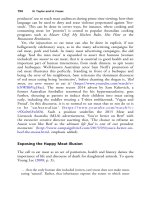The palgrave international handbook of a 496
Bạn đang xem bản rút gọn của tài liệu. Xem và tải ngay bản đầy đủ của tài liệu tại đây (35.15 KB, 1 trang )
Interventions with Animal Abuse Offenders
499
prevention/response as a whole. There is a dearth of empirical information
regarding not only the efficacy and effectiveness of most of the animal abuse
interventions currently in existence, but also about animal abuse itself: rates,
etiologies, typologies, trajectories. We also struggle to compile such basic
statistics as the proportion of animal abuse cases that reach the attention of
the courts or other agencies, the percent of court cases that are prosecuted, the
outcomes of those prosecutions, the ratio of dispositions that include intervention, the frequency of completion of interventions, the availability of
practitioners willing and able to handle cases involving animal abuse, and so
on. Consequently, at present this work relies heavily on anecdotal evidence,
the experience of the authors and their colleagues, and application of theory
from other fields. It is our hope (and a rallying cry throughout this chapter)
that the multiple disciplines and agencies that “touch” upon this issue will
collaborate to plug the gaps that exist in the knowledge base, paving the way
for more empirically supported interventions and a more sophisticated
approach overall to the topic of animal abuse.
Existing Interventions
In presenting interventions currently in use, we begin by reviewing those
directed at adults and then move to those designed for children. However, it
is always important to match the intervention to the developmental level of
the individual, which may be either above or below his/her actual age.
Interventions with Adults
AniCare Adult. AniCare (Jory and Randour 1999) was the first published
intervention for juvenile and adult animal abuse. Based on intimate justice
theory as used in domestic violence interventions (Jory et al. 1997), AniCare
in its original format emphasized helping offenders accept accountability for
their behavior and challenge internalized beliefs that justify abuses of power.
The recently published second edition (Shapiro and Henderson 2016)
addresses a wider range of motivations for animal abuse and incorporates a
broader range of theoretical approaches, including cognitive-behavioral,
attachment, trauma-based, and psychodynamic. AniCare is not a manualized
intervention, but instead guides clinicians in making a thorough assessment
of the factors underlying animal abuse (severity, culpability, motivation/
psychodynamics, attitudes/beliefs, emotional intelligence, family history,









